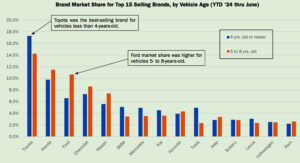Latest trends report shows a jump in total loss frequency for both electric and newer internal combustion engine (ICE) vehicles
San Diego—Mitchell has released its Q1 2024 trends report: Plugged-In: EV Collision Insights. This quarter’s report provides an update on EV total loss frequency, which has risen since late last year as the price of used EVs has fallen. In the U.S. and Canada, EV total loss rates were 9.93% and 7.48% respectively—an increase of approximately 8% from Q4 2023 and 30% from Q3 2023 in both regions. Despite the rise, EV total loss frequency remains in line with 2021 and newer ICE alternatives, which ended the quarter with a rate of 9.51% in the U.S. and 7.44% in Canada.

“Slowing new sales, manufacturer price reductions and changing consumer sentiment are impacting the value of used EVs,” said Ryan Mandell, Mitchell’s director of claims performance. “As a result, the total loss frequency for collision-damaged EVs is increasing. However, it is also increasing for new gasoline-powered vehicles, which are comparable to EVs in terms of their complexity and cost to repair.”

Other notable auto claim differences between EVs and ICE automobiles last quarter included:
- Repair Labor Hours: The average number of mechanical labor hours present on estimates for repairable vehicles was nearly twice as high for EVs as it was for ICE automobiles (3.04 versus 1.66 hours), adding to repair costs.
- Claims Severity: Average claims severity decreased in Q1 but severity costs for EVs continues to outpace ICE vehicles. In the U.S., the severity difference between the two powertrains was $1,363 or 29% ($6,066 versus $4,703) and in Canada it was $1,700 CAD or 33% ($6,810 versus $5,110 CAD).
- Claims Frequency: Even as EV sales slow, claims frequency is growing steadily, rising to 2.26% in the U.S. and 3.41% in Canada. This represents an increase of 40% and 38% respectively over Q1 2023.
- Parts Utilization and Repair: Without a robust inventory of aftermarket and recycled parts, EV collision repairs are more likely to include OEM parts than those completed on ICE alternatives (89.29% versus 65.14%). EV parts tend to be lighter weight to offset a much heavier battery, making them more difficult to repair. In Q1, the percentage of EV parts repaired versus replaced was nearly 13% and, for ICE automobiles, it was closer to 15%.







Comments are closed.